
| Home
| Newbies Guide | Technical Resources
| Lada Niva Clubs | Niva
Lift Kits | Gallery | Links
|

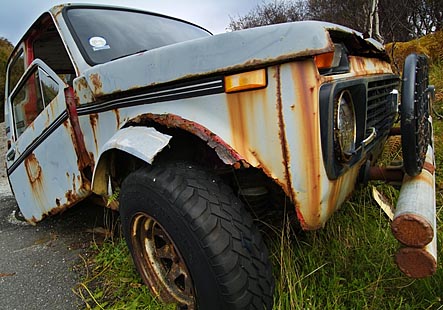
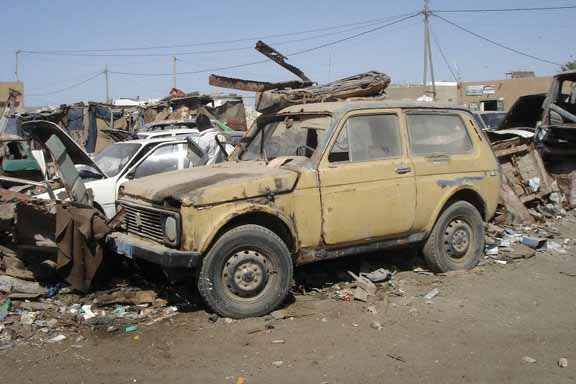
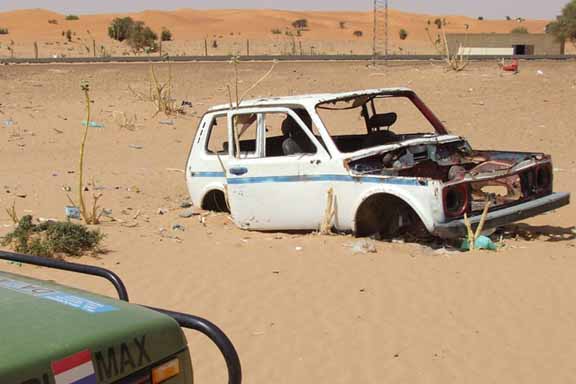
Most Nivas are overall reasonably solid but some can have sporadic paint and
fittings quality so they can rust in some truly odd places - especially
if regular rust proofing is not maintained as per the workshop manual.
Not to mention the effects of road salt, or mud that isn't washed off after
an off-road jaunt.
Luckily Nivas are made from thick steels so if you rust-proof regularly and attend to any rust spots early, you can avoid costly repairs or failures later. Check the manual for the regular rust-proofing necessary, but here's the common areas:
![]() Click on images for a larger view.
Click on images for a larger view.
A common rust trap is a screwed on plate behind the front wheel at the bottom of front guard. It fills up with water & dirt behind it. Take the plate off this weekend and give good wash out if you haven't already.
Wash and dry this enclosure. Note there is a drain hole at the bottom rear of this enclosure (that drains back into the sill (aka rocker panel)) that may be blocked with mud, this needs to be cleared to allow this area to drain properly (in conjunction with your sill dain holes - see below).
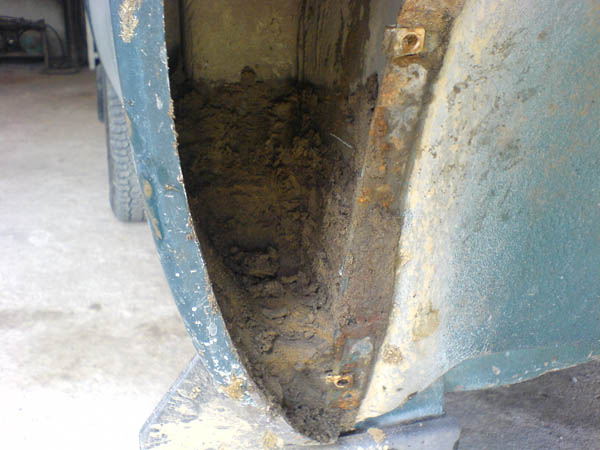
The mud is blocking the small drain at the bottom rear of
this area; this needs to be cleared regularly.
If there is rust after you wash it out, wire-brush it off and kill it with a good rust converter, then repaint (make sure you use waterproof paint, ie undercoat by itself is not usually waterproof). After the paint has dried coat the insides with Fish-oil or similar rust inhibiting layer before replacing the plates. Make sure you don't block the drain hole into the sill at the back of this enclosure when you treat and paint this area.
If there's no rust visable after a good washout, coat the insides with Fish-oil or similar rust inhibiting layer before replacing the plates. Make sure you don't block the drain hole into the sill at the back of this enclosure when you treat and paint this area.
Now make sure you wash out this enclosure once a year from now on. And don't be lazy and just leave the plate off, as you also risk having mud block the drain tubes coming down from corners of windscreen and creating a very serious rust problem.
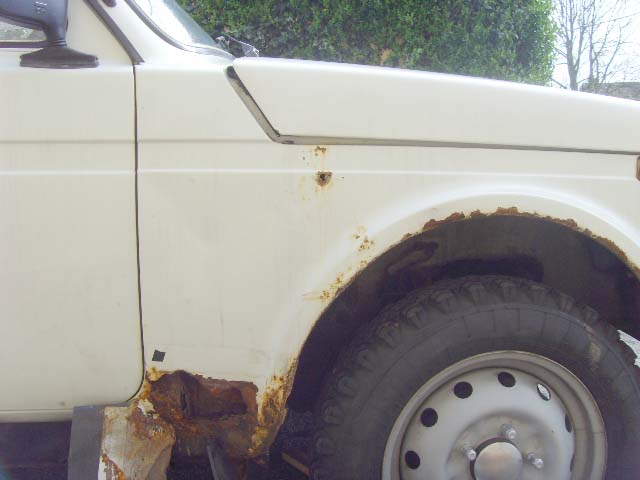
Failure to to clear mud and crap out of here will see these
large holes appear and the insides of your Niva crumble away.
Check all the holes in the 'chassis' aren't filled with mud, wash out and give the insides a good coating of rust killer, and then a rust preventative like Fish-oil.
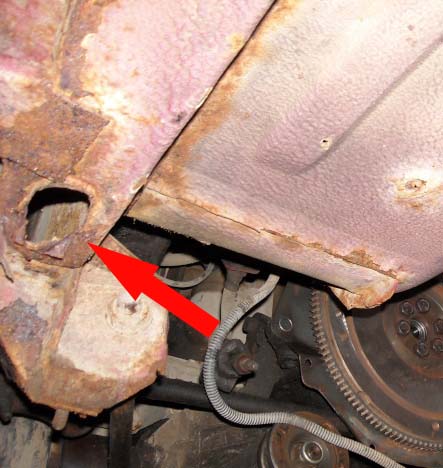
Ensure there's no mud etc in all the chassis nooks and crevices.
Also note in this shot the joins in the steel floor sheets need the rust brushed
or ground off, killed and re-painted to avoid rapid deterioration.
The sills (aka rocker panel, ie under the doors) have small drain slots in the welded seam that can easily become blocked, these should be poked clean every now and again. A squirt of anti-rust is probably a good idea here too, just don't use thick stuff that may risk blocking the drain holes. The doors also have similar drain holes that should be kept clear.
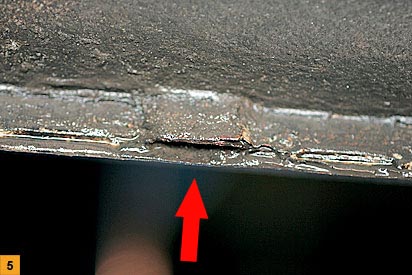
Keep these drain holes in the sills (rocker panels) clear.
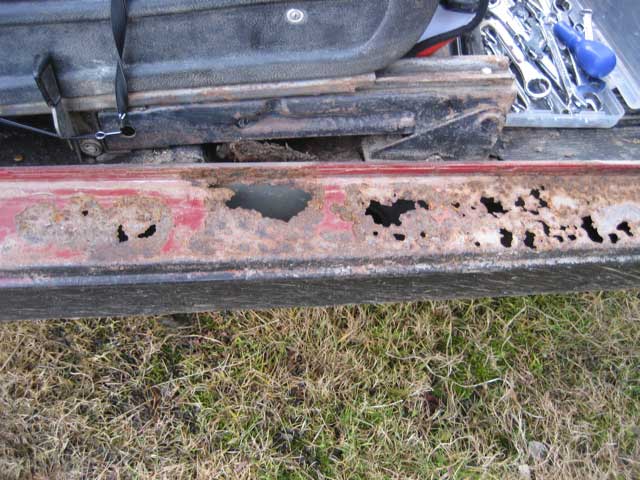
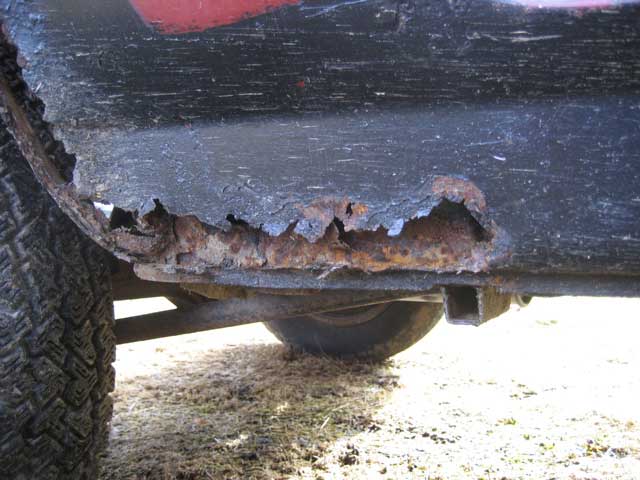
If you don't the sills can become badly rusted (new sills
are available, or you can even upgrade to box-section
steel).
Another weak point to look out for
on the Niva is the where steering-box bolts to the chassis. This is known to
crack and/or rust and could create a serious danger. This is often associated
with the use of wheels with the wrong off-set and/or too wide tyres or too low
tyre pressure.
If you have issues here it's best sorted by having a plate professionally welded
in rather than just welding the existing steel (ie it'll likely just brake
again otherwise).
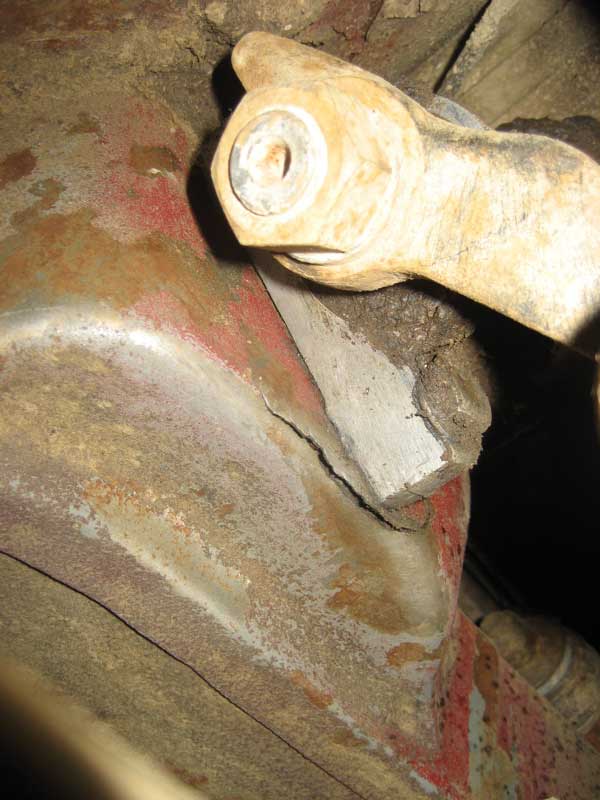
Ripped steering-box mount can be caused by rust, wide tyres,
too low tyre pressure or all three.
Some Nivas have cracking/rusting
problems where the transfer-case or gearbox mount to the floor. This is assumed
to be caused by vibrations from poorly aligned gearbox/transfer-case or worn
out mounting bushes. Cracks will need welded (make sure any welds here
are finished reasonably flat or you may have problems lining the gearbox/transfer-case
up again).
Any hint of rust here is best dealt with (the gearbox or transfer-case
mounts can easily be removed one at a time if you hold the jack the 'box
up with a jack, make you sure you align it before
you bolt it back up).
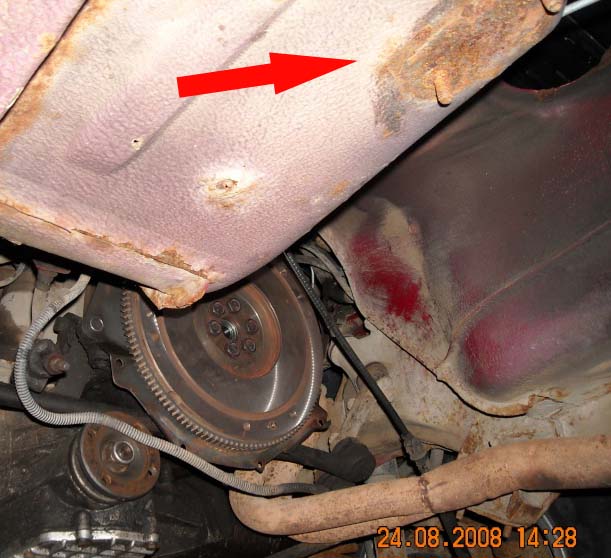
Signs of rust around mount can mean worse rust under the
mount.
Check under your front 'carpets',
if damp or signs of rust there's water getting in somewhere that will need to
be stopped (and of course the rust killed), if you don't want a Flintstone's
car.
The rubberised paint coating is very thick here which is good at delaying rust,
but it's also good at hiding rust once the water's seeped through
it (especially once the rubberised paint has got old and cracked).
Leaky windscreen seals and the heater drain are two common sources.
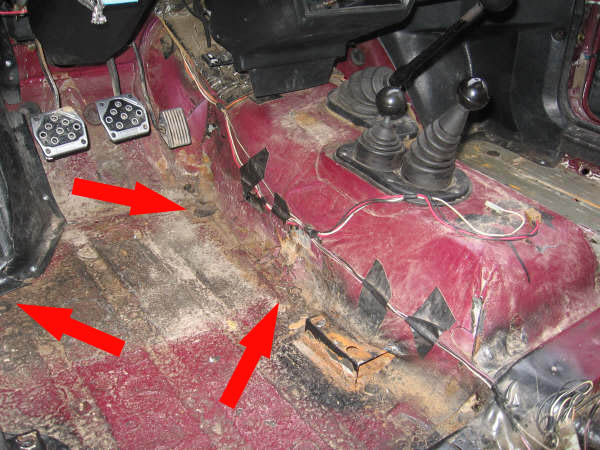
Common
rust areas on the inside floor
Re-rubbering the floor is a good idea if your rubber's old
and cracked, but make sure you kill any rust first and paint with water-ptoof
paint, and don't block ay drain holes.
The rear interior can be worth checking for rust as well.
The part of the 'chassis' behind the rear wheel has a rubber bung in it. Check for rust in this area (especially if you do towing or use the tow-bar as a recovery point). Pop the bung out and clear out any dirt or moisture from inside, spray with anti-rust if it was damp, give the insides a good coat of fish-oil or rust preventative. and replace the bung.
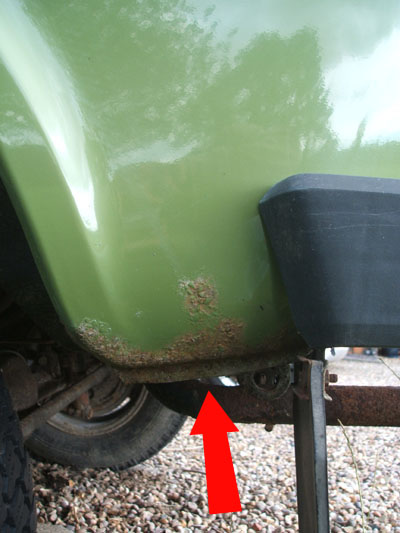
Rubber bung plug is on the underside. This is what happens if
you let mud and crap sit in there.
Rust at the top of the A-pillar is not unusual where the two different steels have been joined. It's usually just surface rust, but kill it when you can, as unattended it'll become a serious and dangerous problem.

Rust is common here, easy to clean away if not left - so
kill any you have now before it gets a hold.
Shine a torch into the gap between the front doors and front guards; a wee blast of rust killer and fresh paint could save heartbreak in a few years time. Check the doors' hinge mounts as well.
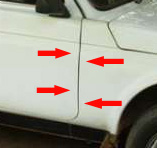
Structural rust around door hinges can be dangerous - kill
any you have now before it gets a hold.
The window trim on the door can hide rust (possibily caused by the trim's clips and edges scraping the paint). Easily sorted if not ignored.
Check around the windscreen for small patches or bubbles of rust under the paint. Dealing with these now will prevent major work later.
If the sealant has cracked on the base of the A-pillar serious rust can hide underneath
If there's any sign of rust under the rear hatch's hinges it should be attended to as it'll likely be worse under the hinge mount (an easy job, but unfortunately you need to lift some of the roof lining to get to the bolts).
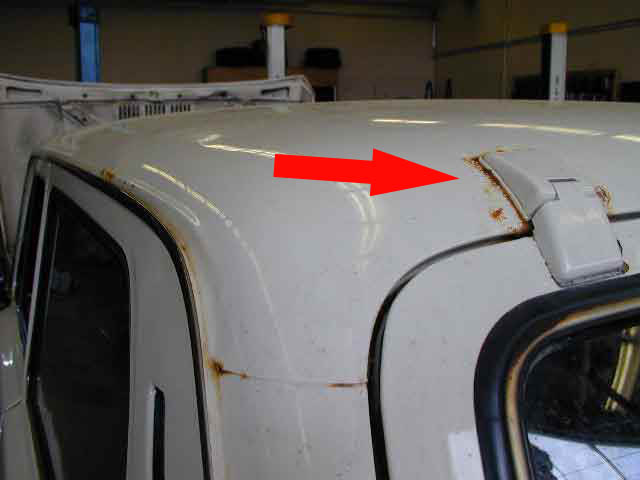
Attack rust early here - any hint of rust here can be worse
underneath; unfortunately you need to carefully remove the roof lining to take
the hinges off.
Many Mk1 Nivas have rust under the rear door trim (I suspect they used self-tapping screws here after the door had been painted). Easily cleaned up, but will ruin the door if not.
Off-roading
Mud holds moisture and road salt, so always give your Niva a good hose down in all the underneath crevices on the floor, and right up inside the wheel-arches, etc after playing in the mud or sand (high pressure hoses are great for this). This is essential to do as soon as possible if you've been playing in beach sand or the sea. Repaint any underbody scrapes and dings before they get a chance to rust.
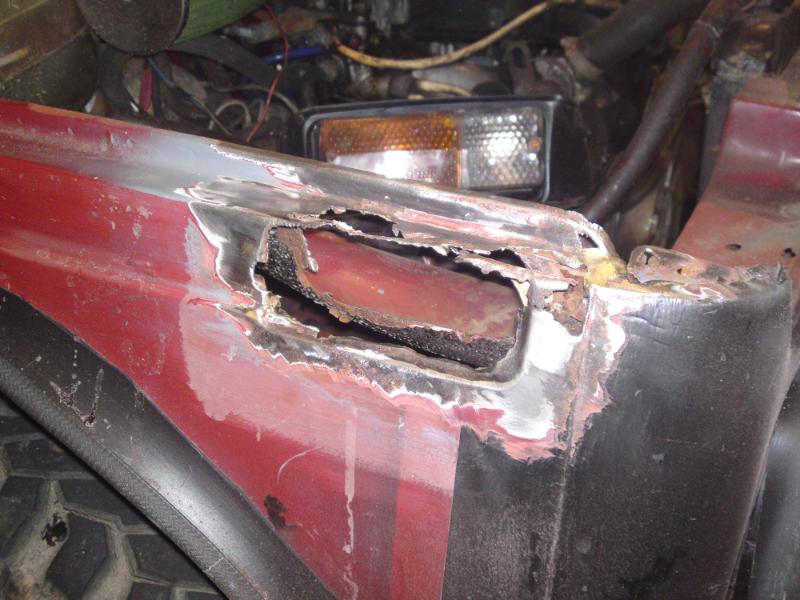
Hose right up in behind the wheel-arches after playing off-road,
as there's mud traps like the indicator shroud which trap mud and cause rust.
I also fully clean, rust-proof, Fish-oil, the whole 'chassis' and floor every couple of years. And sometimes give it a new coating of spray-on rubber to finish.
| Home | Newbies Guide | Cloggy's DOHC | Lada Niva Clubs | Niva Lift Kits | Gallery | Links |
Please read the General Disclaimer near the bottom of this page